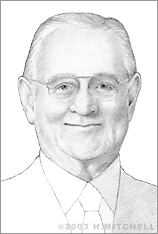Charles Draper
Charles Stark Draper created a variety of gyroscopic instruments that revolutionized the design of guidance and control systems for navigation, particularly for military applications. Born in Windsor, Missouri on Oct. 2, 1901, he attended the University of Missouri, moving on to Stanford University in 1919, where he completed a BA in psychology in 1922. Later that year, he entered the Massachusetts Institute of Technology (MIT), where he earned his SB in electrochemical engineering in 1926, an SM in 1928, and a ScD in physics in 1938.
Draper became an assistant professor at MIT in 1935 in the Department of Aeronautics and Astronautics. He continued to teach at MIT for the duration of his career, where he held posts of Associate Professor, Department Head for Aeronautics and Astronautics, and in 1966, Institute Professor. Throughout his tenure, he conducted research related to navigation and control systems, working first under sponsorship by the Sperry Gyroscope Co. With this grant, Draper developed the Mark 14 gun sight, which was used during World War II. He acquired the nickname “Mr. Gyro” in the 1950s as he continued to work on gun and bomb pointing, rocket pointing, and firing control systems.
Draper’s focus was in applying gyroscopes, or devices that rotate in reaction to change in direction, to these types of systems by feeding information obtained by gyroscopes and accelerometers into computers, which would then calculate any deviation from an intended course or target and recommend corrective action. Draper’s “inertial guidance systems” were able to automatically sense minute degrees of drift and correct them quickly – resulting in very precise navigation. When Draper designed his spinning gyroscope to stabilize anti-aircraft gun sights, this enabled the development of guidance systems for launching long-range missiles at jet targets. His work also greatly helped Project Apollo and affected virtually all U.S. strategic missile deployment programs.
For instance, in 1942, the USS South Dakota shot down 32 Japanese attacking aircraft using Draper’s gun sight technology. Following in 1949 was the first employment of his inertial guidance systems and properties of gyroscopic instruments for aircraft navigation. In 1954, the technology proved successful in tests for marine vessels as well.
The Charles Stark Draper Laboratory, Inc. at MIT was formed in 1973 as a separate, nonprofit research and development laboratory. Since 1957, Draper's Lab has developed guidance systems for the U.S. Navy. Draper himself earned more than 70 awards throughout his lifetime, including the Langley Medal of the Smithsonian Institution, the NASA Public Service Award, the Dr. Robert H. Goddard Trophy of the National Space Club, and the National Medal of Science from President Lyndon Johnson. He was also inducted into the National Inventors Hall of Fame and the International Space Hall of Fame.
He served as president of the International Academy of Astronautics, was a fellow of the American Physical Society, the American Academy of Arts and Sciences, the American Society of Mechanical Engineers, the Institute of Electrical and Electronics Engineers, and other national scientific organizations, and was a member of the National Academy of Engineering, the National Academy of Sciences, and the French National Academy, among others.
In 1978, MIT established the Charles Stark Draper Professorship of Aeronautics and Astronautics in Draper’s honor. He died on July 25, 1987. In his memory, the Draper Laboratory endowed the Charles Stark Draper Prize, an annual, international engineering award administered by the National Academy of Engineering.


